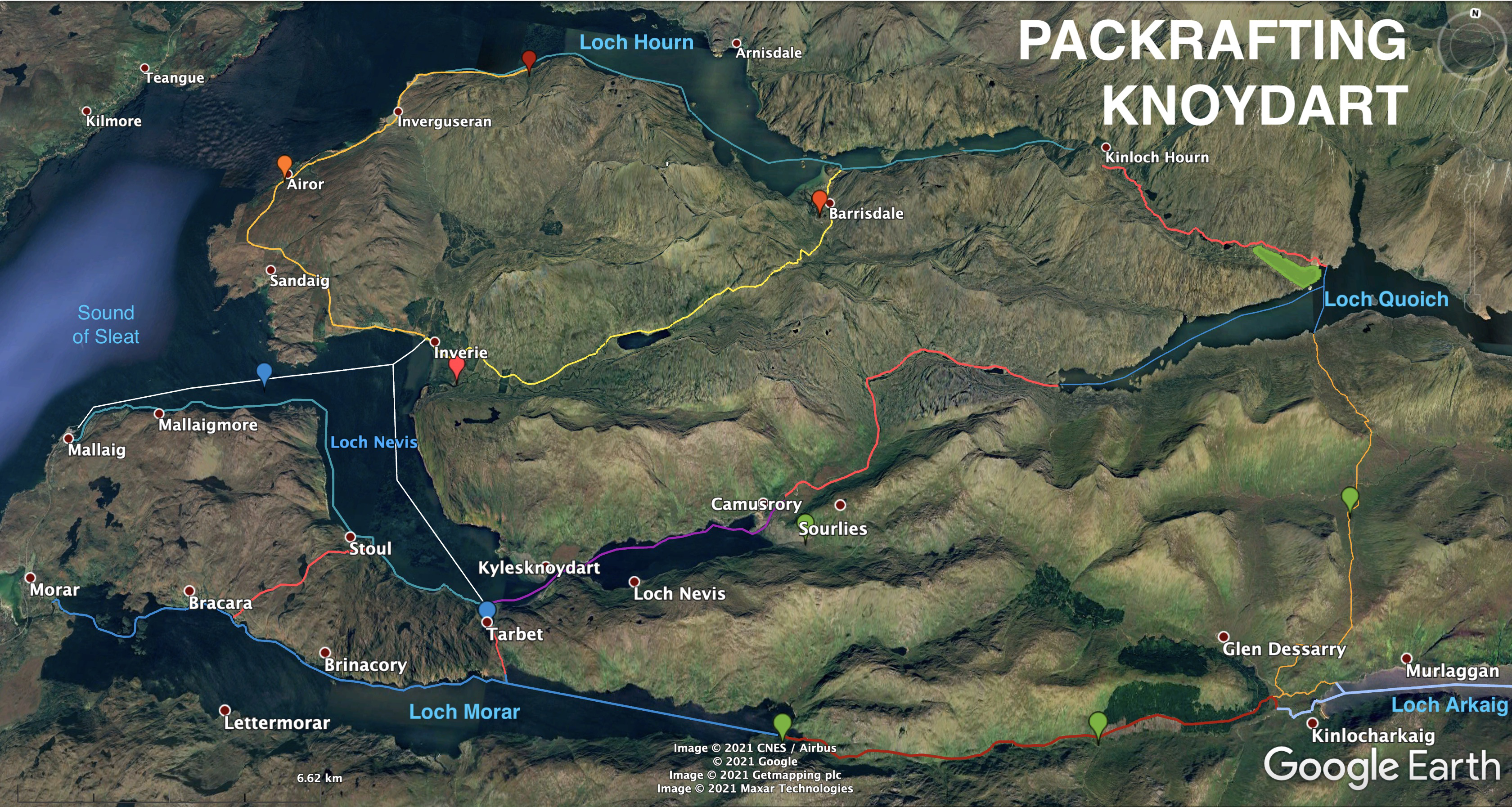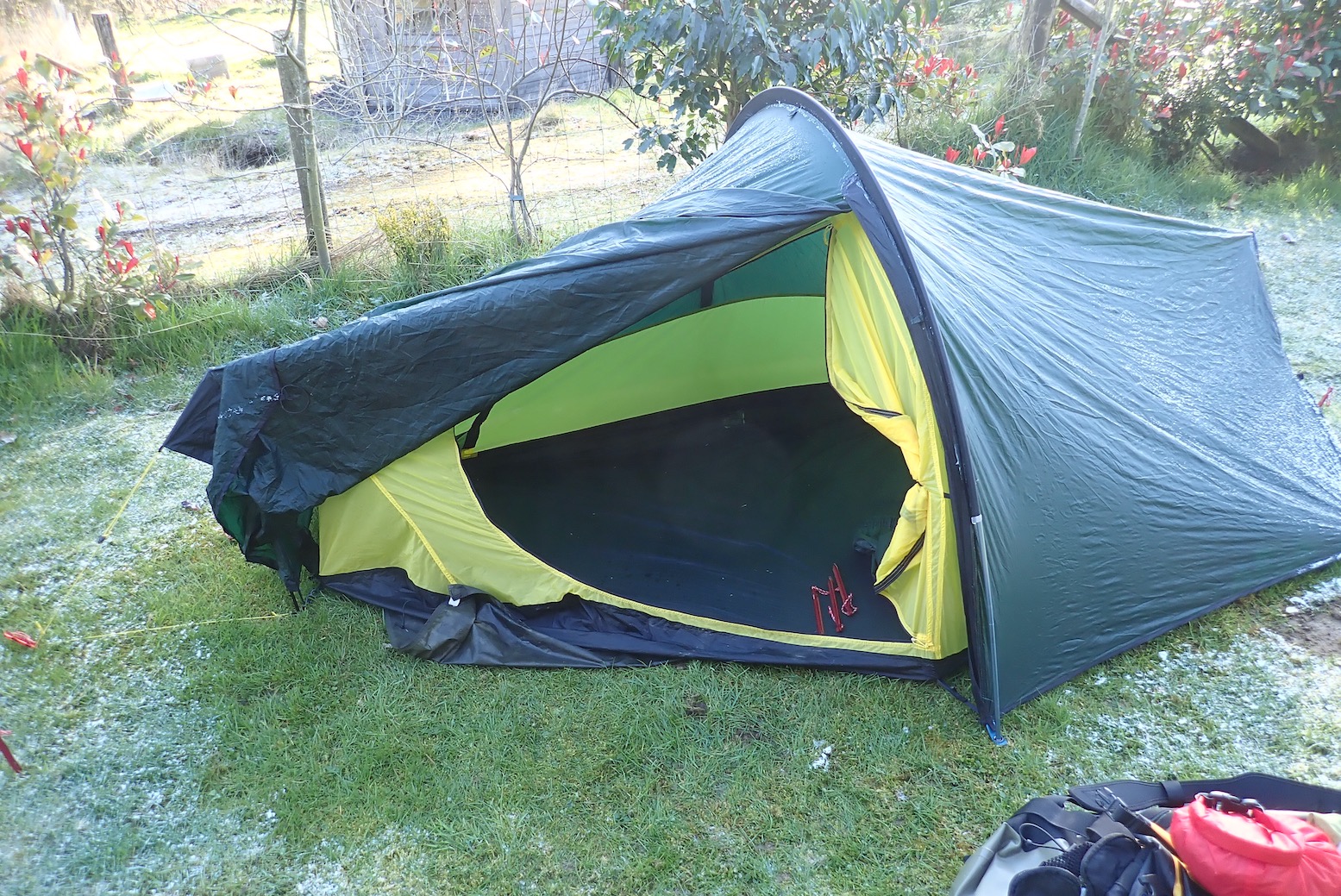Sigma TXL main page
see also:
Sailing with Rebel 2K
Sailing with MRS Nomad
As the calendar flipped into June the crap May weather – worst for decades locals say – had finally broken, and northwestern Scotland sits under a High with cool, light winds and blue skies. After weeks of the opposite, it can all look a bit miraculous. The other day we climbed Ben Hope, Britain’s most northerly 3000-footer. It’s a short, steep climb, and coming back down I was sure pleased to lean on my packstaff (right).

Back home, paddling the southern edge of Enard Bay in an arc from Garvie Bay around to Achnahaird beach (left) was another easily realised sea packrafting outing. It’s also our favourite local half-day walk and with today’s strengthening northerly breeze, I ought to be able to sail down into Achnahaird, wade up the stream to the twin freshwater lochs, and carry on sailing nearly all the way back to Badentarbet. All up that would be about 18 kms of paddling and walking.


It’s a muddy kilometre’s walk from the road bridge down to Garvie beach which, unlike popular Achnahaird, is usually deserted. I did carry my old Grabner IK down on my head one time for a paddle to Lochinver, but a packraft in the pack is so much easier. This car-free and approach/portaging ease was part of the rationale in putting all my eggs in the TXL basket and flogging the Seawave.

Even before I reached the shore it was clearly a bit windier than the predicted 6mph, but as long as white capped waves held off (the easily spotted warning sign for inflatables) it should be OK. The chilly northerly coming off the sea was steady; less gusty (or so the forecasts suggested) so I was glad I grabbed the dry-suit last minute.
As you can see from the Google image above, the rough shoreline and reefs can kick up some breakers, but if it all got a bit much I knew plenty of take-outs to join the Mrs who was doing the walk and taking photos from above.

Skeg effectiveness
Anfibios mount the skeg sloping down on the hull’s short stern. Selfies I’ve taken on previous TXL paddles show the skeg halfway out of the water, unless the boat is very heavily loaded. The air floor lifts the boat higher still.
This was not an issue in my rear-weighted Rebel 2K single seater where I pushed the back end down. On the level-trimmed and more buoyant TXL, the skeg is ill positioned or too small.


Fitting the skeg backwards puts more in the water, but sticking another mounting patch at the back of floor sheet like an IK (above right) is fully effective. People ask: would the lack of inflated skeg support be that bad without the firm backing of the air-floor or a rear paddler’s seat? No; and the long, low stock Anfibio skeg is just the right shape.


Mounting another skeg patch on the floor is a bit time consuming is what I ended up trying so I can keep the stock skeg. Today I’m trying a spare Gumotex skeg (right) whose slip-in mount system the Anfibio skeg copies, but which has a deeper profile putting more plastic in the water. It’s only less than half a hand’s worth, but is worth a go before fabricating a skeg extension or repositioning it.

Today I’m also trying my longer, smaller-bladed, 230-mm Camaro sea-kayaking paddle more suited to steady cruising into the wind than the over-sized, white-water Corryvreckan I’ve been using so far. Initially I can feel the paddle’s extra weight, but that’s soon forgotten which suggests the slimmer blades are just right. Progress is a bit sluggish into the northerly, but I’m getting the feeling it’s always like this with the bloaty TXL until the arms warm up.

I wonder if coming round the point and turning west into Camas a Bhothain (‘bothy bay’) may get a bit lively, but the TXL takes it all in it’s stride. It’s easy to spot where waves break over reefs and, sat low on the broad, 15-cm-thick seatbase, stability is never an issue and for a packraft, the TXL tracks well across the side wind and waves, perhaps helped by the Gumboat skeg and my masterful technique.

It’s only 4km beach to beach and soon I’m threading through the western Rubha Beag skerries and turning south with the wind for Achnahaird.

Out here in the open the waves are bigger with the odd white cap rolling past, but incredibly the boat feels fine. In a normal solo packraft I suspect I’d be a bit freaked out. The bigger boat makes you feel less vulnerable and the high sides keep the splash out and don’t seem that affected by ~10mph side winds (something I discovered on my first sea outing in Dorset).

I paddled out into Achnahaird Bay (or so I thought) to get a straight run for the beach, then flipped out the WindPaddle. Only things don’t go so well. Just like the other day when I blamed the front skeg, the TXL is weathercocking (back coming round, below). This time I blamed a too shallow skeg lifting out on wave crests at which point the wind pushes the untethered stern around – the boat pivoting around the sail’s ‘mast’ on the bow.
I’ve had this before sailing a IK on Ningaloo Reef in northwest Australia (tall-sided Ik and too short a rudder for the winds). In the TXL my central ‘kayak’ rather than rearward ‘packraft’ seating position doesn’t help. The (loaded) Rebel 2K sailed fine in similar conditions; so did my unloaded Nomad S1 one time, as well as Barry’s loaded Nomad last year in Knoydart. With its skeg on, the MRS Nomad sailed well, with or without a load. Along with its pointy ends, I put that down to its fully submerged skeg.
Meanwhile in the TXL you can see my annoying zigzagging track on the left. Hoping to slice across the bay like a blue-fin tuna, it was all a bit frustrating, but I inched in the right direction quicker than it felt and was pretty sure weight distribution and skeg depth were the culprits. And in fact I saw later the GPS was logging a steady 6kph, it just wasn’t the steady linear progress I’ve had sailing other packrafts.

Once at Achnahaird I paddled as far as I could up the burn running alongside the beach, then hopped out and waded upstream – easier than carrying the boat in the wind.


Near the road junction it’s a 2-minute carry over to freshwater Loch Raa where I hoped the lower waves would give the skeg some traction. But it was the same zigzagging progress. Waves combined with a shallow skeg were not causing the weathercocking (as they had in the Bay). So the problem had to be weight distribution. I remembered a canoeing adage: “sit up front into a headwind; sit at the back downwind“. You are the flagpole from which the boat should trail downwind. After a short portage over into Loch Vatachan, I sat right at the back and progress did seem a bit straighter, as the GPS tracklogs below show. I was no faster: 6kph downwind and 5ph on the ‘off-wind’ zags, but there was less zigzagging.


By the time I reached the south end of Loch Vatachan to pack up, the wind was fairly brisk (left). Packraft sailing should be better than this but moving to the back of the boat to enable reliable tracking under sail is not so practical. The answer must be a bigger or repositioned skeg.


A couple of days later we went for a short paddle in a reasonable sailing wind. The stock skeg was on back to front (right) and with the Mrs’ added ballast I hoped it might bite under sail.
Unfortunately it was the same story of the stern coming round even if the speeds were again OK. On a beach we went for a wander and found a nice bit of broken plastic fish crate. We’re gonna need a bigger skeg.


During the stop I took the TXL out for a spin sat in the back. Of course the bow was up in the air and yawing like a giraffe, but it was quite a revelation to have a spacious boat extending out in front of me like a kayak. My front seatbase made a spacious footrest and I could lean on the back like a normal sized packraft. Sat in the back, as a way of touring or bikerafting, a bike over the bow and baggage in the front would correct the trim a little. And with the 200 litres of dry storage capacity inside the TubeBags, you could probably move house with the TXL.
We paddled the last mile to Badentarbet with me in the back. Again this felt much more comfortable for me – it must be the ability to lean on the stern. Meanwhile the Mrs said she felt no more cramped than the back. Yes the trim was still off (left), but so it always was on my 2K and I got around in that with no problems.
That’s the great thing with the TXL: there are all sorts of ways of using it.




















































































































































































































